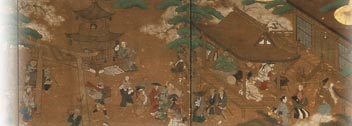International Symposium: “The Picturesque in Film and Theatre”
Outline
| date | January 17 - 19, 2011 |
|---|---|
| Venue | Waseda University (Ono Auditorium) |
| Organizer | |
| outline | An international symposium on “The Picturesque in Film and Theatre,” sponsored by the Waseda University Tsubouchi Memorial Theatre Museum’s Global COE program, the International Institute for Education and Research in Theatre and Film Arts, was held over three days, on the 17th, 18th and 19th of January 2011. By approaching film and theatre from the perspective of the picturesque, this symposium raised new challenges for both film studies and theatre studies. The rich variety of research themes and high quality of scholarship attracted the attention of researchers from both Japan and abroad, and the symposium was a great success. |
Details
Associate Professor Luc Vancheri (Université Lyon 2) opened the session on the 17th with a talk on “Criticism and Cinematographic Survivals of the Picturesque” in which he suggested that the critical thread of an aesthetic opposed to the values of the picturesque survives in contemporary film. Citing the slowly moving space in Mark Lewis’s landscape film, Algonquin Park, Early March as a particularly important example, he discussed the way it both releases and renews the power of “the pictorial.” In the next talk, “From the Pictorial Arts to Scenery, from Scenery to Film Art,” which made abundant use of pictorial material in the Tsubouchi Theatre Museum collection, Professor KODAMA Ryuichi (Waseda University, Graduate School of Letters, Arts and Sciences) showed how the backdrops for Japanese puppet theatre performances stage sets were adopted in the backdrops that featured in a special type of Kabuki performance known as “ningyo buri,” which made use of an extreme form of perspective; and how backdrops in theatre (Kabuki) had an enormous influence on the backdrops of early Japanese cinema. Next, in a paper entitled “The Two-dimensionality of Film and the Pictorial Arts” Professor KOMATSU Hiroshi (Waseda University, Graduate School of Letters, Arts and Sciences), one of the planners of this symposium, presented his thoughts on the central issue of this symposium, which is “In what sense is a film like a painting?”, in the context of the history of silent films from the end of the 19th century to the latter half of the 1920s. After that, in “The Picturesque in Early Non-Fiction Film: The Cameraman’s Contribution,” Stephen Bottomore, a specialist in early documentary films, showed that the high technical and artistic qualities of non-fiction films prior to 1915 can be explained by the fact that many of the cameramen of these early films were trained in still photography. Cameramen in the infancy of cinema were heavily influenced by picturesque photography. Adding immeasurably to the audience’s enjoyment of the screening of these rare picturesque silent films was the piano accompaniment by YANASHITA Mie, who has performed internationally.The next day, January 18th, Associate Professor Casper Tybjerg (University of Copenhagen) gave a presentation titled “Distinguished Compositions: The Use of Paintings as Visual Models in Danish Silent Films” in which he discussed the effective use of well-known paintings in Danish silent films, especially the relation between the paintings of Vilhelm Hammershøi and the films of Carl Th. Dreyer. Next, Professor Pierre Frantz (Université Paris-Sorbonne Paris-IV) addressed the subject of “Theatre and the Pictorial Model in the 18th Century.” As one example, he discussed the points of contact between the painter Jacques-Louis David and the theatre. David was inspired by the theatricality of neoclassicism, but the actor Talma and set and costume designers and playwrights in turn were influenced by paintings by David and his students. Thus, he showed that the theatricality of neoclassicism, which emphasized spectacle, is in fact very close indeed to the theatricality of romanticism with all its aesthetic, ideological and political significance. The session concluded with a talk by Professor TAKEDA Kiyoshi (Waseda University, Graduate School of Letters, Arts and Sciences), “Painting in Film: Light, Continuance, Sound and the Artist’s Body.” In it he analyzed the similarities and differences of four themes relative to painting and artists that are found in films, namely, color and light, stillness and movement (condensation and continuance), picture and sound, and the artist’s body (as manifested or concealed). When both the commonalities and differences are encountered in a film, the mystery this gives rise to, he argued, provides insights not only into the pictorial arts and film but also into the very process of representation itself.
On the final day, presentations were made by seven GCOE students. The two-hour discussion of these papers between the students and the four guest lecturers was, as it were, a group teaching session for the students and provided a superb opportunity for both sides to see the direction the International Institute for Education and Research in Theatre and Film Arts is taking. (DAIBO Masaki, research associate)
January 19, 2011: Papers presented by Global COE students
“Scenography of Léonard-Tsuguharu Fujita,” SANO Katsuya (Waseda University Graduate School of Letters, Arts and Sciences, doctoral course)
“Filming Unfinished Paintings: Painting in El sol del membrillo (Quince Tree of the Sun),” MIYAMOTO Akiko (Waseda University Graduate School of Letters, Arts and Sciences, doctoral course)
“Evgeni Bauer and Painting: An Analysis of Bauer’s Works from the Perspective of Scenography,” OGAWA Sawako (Waseda University Graduate School of Letters, Arts and Sciences, doctoral course)
“Japanese Scenery in Early Hollywood Cinema: On the Dragon Painter (1919),” SHIMURA Miyoko (Waseda University Graduate School of Letters, Arts and Sciences, doctoral course, completed)
“An Analysis of Director MAKINO Masahiro’s Hanako-san (1943): The Picturesque during Wartime,” KAMIYA Makiko (Waseda University Graduate School of Letters, Arts and Sciences, doctoral course, withdrew)
“The Relation between Dance and Scenic Designs by Artists in the Early Works of the Ballets Russes (1909–13),” KITAHARA Mariko (Waseda University Graduate School of Letters, Arts and Sciences, doctoral course)
“Picturesque Theatrical Images into Film: KUROSAWA Akira’s Ran,” Mátrai Titanilla (Waseda University Graduate School of Letters, Arts and Sciences, doctoral course, completed)
Discussion of the papers presented by the students


